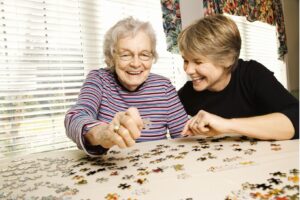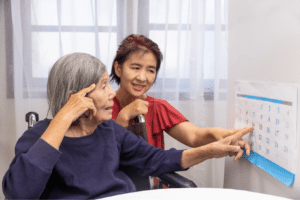If your loved one is able to understand a home safety evaluation, be sure to go over it with them in detail.
Image source: Flickr user River Arts
You’ve made sure your elderly loved one has a warm, safe roof over their heads, healthy and nourishing food, and maybe even a professional home care worker to look after them. You’ve done everything you can to ensure they live a long and comfortable life in their own home. But have you ever considered using home safety evaluations? They’re commonplace in facilities like nursing homes and sub-acute rehabilitation centers, but many people don’t know how important they are in personal residences as well. What follows are some basic home safety measures that can help protect the senior in your life.
Example of effective home safety evaluation
One of the biggest dangers to seniors living at home is falls. In fact, according to the Centers for Disease Control and Prevention, one-third of seniors over sixty-five fall every year in the United States. It’s no wonder then that falls are the leading cause of injury, permanent disability, nursing home placement, and even death. Something that a younger person might recover from in a fall (such as a broken hip) can be fatal to a senior. Therefore, when considering a fall risks, keep the following hazards in mind:
- Frayed rugs
- Objects on floor
- Not enough handlebars (especially in the bath or shower)
- Medications that may make a person dizzy
- Broken or icy steps
- Improper lighting, especially for seniors with poor vision
Another danger that often goes unmarked is the potential for fires. It can be difficult for seniors – whose physical and cognitive capabilities may be dwindling – to keep up with home maintenance the way they used to. As such, fire hazards in the home may include:
- Dangling electrical sockets
- Clothes thrown over a radiator
- A patient with dementia forgetting to turn off the stove
How to assess for potential dangers
Walk through each room of the house and mark down potential hazards. Make notes for later about how you’re going to tackle them. For instance, for some of the risks outlined above, here is what you might hypothetically prepare the following:
For falls:
- Replace or repair frayed rug in living room
- Remove hazardous objects on floor of bedroom
- Install handlebars in bathrooms
- Assess medications that may cause dizziness
- Fix steps to backyard; take precautions to combat ice on steps in winter
- Procure additional lighting for bedroom; have vision checked regularly
For fires:
- Replace or repair broken electrical sockets in garage and basement
- Remove clothing or other objects from around radiators; procure extra storage as needed
- Make sure patient’s dementia is being treated, and that he or she is supervised at all times
Other examples of home safety evaluations can be found here.
Make sure everyone knows about the home safety evaluation
If you’ve initiated a home safety evaluation, it is essential to share it. Naturally, if your elder has the cognitive skills to understand it, they are the first person who should know about the evaluation. Go over it with them in detail, explaining the reason for each safety measure. Tell them to let you know if any of these measures are not being taken, or if they feel the need for additional ones.
The next step is to make sure anyone coming to your senior’s home knows about the checklist, and follows related instructions. This may mean having a home health aid do a quick daily inspection of objects on the floor that could cause a fall. It may mean having a visiting nurse do a cognitive assessment to determine if your loved one’s Alzheimer’s has worsened. The important thing to remember is that the checklist only works if every member of the team consistently considers it.
Put home safety evaluations in place for your loved one today
If your senior is at risk for falls or other types of injuries, home safety evaluations are essential. Although they’re a bit of work at the beginning, there’s no better tool to prevent injury and accidents to your loved one at home. Once you’ve worked out the details and made sure the entire healthcare team is on the same page, you can be assured of having taken great strides towards protecting your senior.
If you are unsure of how to best help an aging loved one, the trained and compassionate staff at the Institute on Aging is here to help you make that decision and gain the best in at-home senior care. Contact us to find out more.







